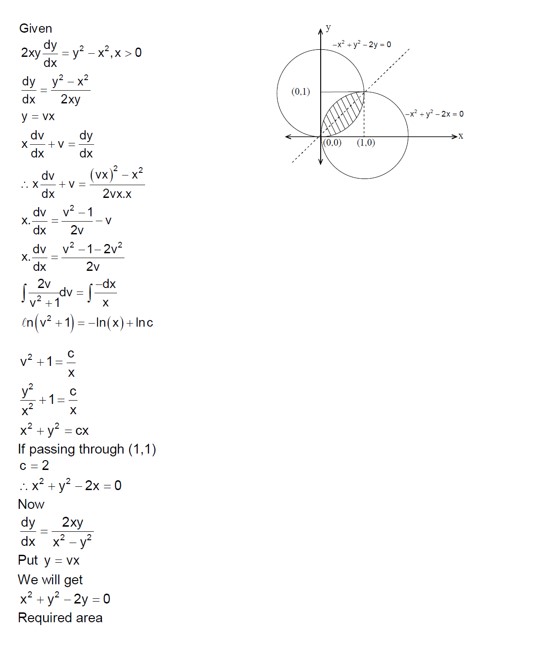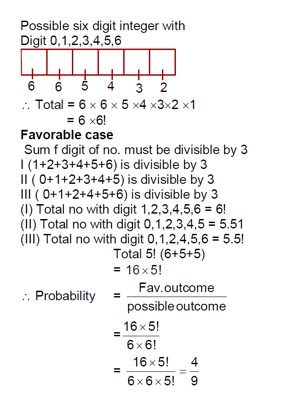Class 12th
Get insights from 12k questions on Class 12th, answered by students, alumni, and experts. You may also ask and answer any question you like about Class 12th
Follow Ask QuestionQuestions
Discussions
Active Users
Followers
New answer posted
2 months agoContributor-Level 10
Given r x a = b x r, which means r x a + r x b = 0, so r x (a+b) = 0.
This implies r is parallel to (a+b). So, r = λ (a+b).
a = I + 2j - 3k, b = 2i - 3j + 5k
a+b = 3i - j + 2k.
r = λ (3i - j + 2k).
Given r ⋅ (αi + 2j + k) = 3. The OCR is unclear, but the equation appears to be r ⋅ (αi + 2j + k) = 3. The solution works with r ⋅ (αi + 2j + k) = 3, but theOCR says r. (ai+2j+k). Let's assume it's α.
λ (3i - j + 2k) ⋅ (αi + 2j + k) = 3
λ (3α - 2 + 2) = 3 => λα = 1.
Given r ⋅ (2i + 5j - αk) = -1.
λ (3i - j + 2k) ⋅ (2i + 5j - αk) = -1
λ (6 - 5 - 2α) = -1 => λ (1 - 2α) = -1.
From λα = 1, α = 1/λ.
λ (1 - 2/λ) = -1 => λ
New answer posted
2 months agoContributor-Level 9
f (x) = (4a - 3) (x + ln5) + 2 (a - 7)cot (x/2)sin² (x/2)
= (4a - 3) (x + ln5) + (a - 7)sin (x)
f' (x) = (4a - 3) + (a - 7)cos (x)
For critical points f' (x) = 0
cos (x) = - (4a - 3) / (a - 7) = (3 - 4a) / (a - 7)
⇒ -1 ≤ (3 - 4a) / (a - 7) ≤ 1
Solving this inequality leads to:
⇒ a ∈ [4/3, 2]
New answer posted
2 months agoContributor-Level 10
P (x) = x² + bx + c.
Given ∫? ¹ P (x) dx = 1.
∫? ¹ (x² + bx + c) dx = [x³/3 + bx²/2 + cx] from 0 to 1 = 1/3 + b/2 + c = 1.
2 + 3b + 6c = 6 => 3b + 6c = 4 - (i)
When P (x) is divided by (x-2), the remainder is 5. So, P (2) = 5.
(2)² + b (2) + c = 5 => 4 + 2b + c = 5 => 2b + c = 1 - (ii)
From (ii), c = 1 - 2b. Substitute into (i):
3b + 6 (1 - 2b) = 4
3b + 6 - 12b = 4
-9b = -2 => b = 2/9.
c = 1 - 2 (2/9) = 1 - 4/9 = 5/9.
We need to find 9 (b+c).
9 (2/9 + 5/9) = 9 (7/9) = 7.
New answer posted
2 months agoContributor-Level 10
dy/dx + (tanx)y = sinx. This is a linear differential equation.
Integrating Factor (I.F.) = e^ (∫tanx dx) = e^ (ln|secx|) = secx.
The solution is y * I.F. = ∫ (sinx * I.F.) dx + C.
y * secx = ∫ (sinx * secx) dx = ∫tanx dx = ln|secx| + C.
Given y (0) = 0.
0 * sec (0) = ln|sec (0)| + C => 0 = ln (1) + C => C = 0.
So, y * secx = ln (secx).
y = cosx * ln (secx).
At x = π/4:
y = cos (π/4) * ln (sec (π/4) = (1/√2) * ln (√2) = (1/√2) * (1/2)ln (2) = ln (2) / (2√2).
New answer posted
2 months agoContributor-Level 10
The equation of the circle is x²+y²+ax+2ay+c=0, with a<0.
x-intercept = 2√ (g² - c) = 2√ (a/2)² - c) = 2√2. So, a²/4 - c = 2 => a² = 8 + 4c - (i)
y-intercept = 2√ (f² - c) = 2√ (a² - c) = 2√5. So, a² - c = 5 => a² = 5 + c - (ii)
Equating (i) and (ii): 8 + 4c = 5 + c => 3c = -3 => c = -1.
Substituting c in (ii): a² = 5 - 1 = 4. Since a < 0, a = -2.
The equation of the circle is x² + y² - 2x - 4y - 1 = 0.
Completing the square: (x-1)² + (y-2)² = 1+4+1 = 6.
The center is (1,2) and radius is √6.
The tangent is perpendicular to the line x + 2y = 0 (slope -1/2).
So, the slope of the tangent is 2.
Equation of the tangent: (y-2) = 2 (x-1)
New answer posted
2 months agoContributor-Level 9
K.E = φ - φ?
φ? = 3 eV = 3 * 1.6 * 10? ¹? J = 4.8 * 10? ¹? J
φ = hc/λ = (6.63 * 10? ³? * 3 * 10? ) / (248 * 10? ) J = 8 * 10? ¹? J
K.E = 8 * 10? ¹? - 4.8 * 10? ¹? = 3.2 * 10? ¹? J
Now using, λ = h / √ (2 K.E m)
λ = (6.63 * 10? ³? ) / √ (2 * 3.2 * 10? ¹? * 9.1 * 10? ³¹) m
λ = (6.63 * 10? ³? ) / (7.63 * 10? ²? ) m = 0.87 * 10? m = 8.7 Å
So, the nearest integer is 9.
New answer posted
2 months agoContributor-Level 9
T? = 300 K; K? = 1 * 10? ³ s? ¹
T? = 200 K; K? =?
E_a = 11.488 kJ/mol
Using Arrhenius equation:
log (K? /K? ) = (E_a / 2.303R) * [ (T? - T? ) / (T? )]
log (K? / 10? ³) = (11.488 * 10³ / (2.303 * 8.314) * [ (-100) / (6 * 10? )]
log (K? / 10? ³) = -1
K? / 10? ³ = 10? ¹
K? = 10? s? ¹ or K? = 10 * 10? s? ¹
Taking an Exam? Selecting a College?
Get authentic answers from experts, students and alumni that you won't find anywhere else
Sign Up on ShikshaOn Shiksha, get access to
- 65k Colleges
- 1.2k Exams
- 679k Reviews
- 1800k Answers




